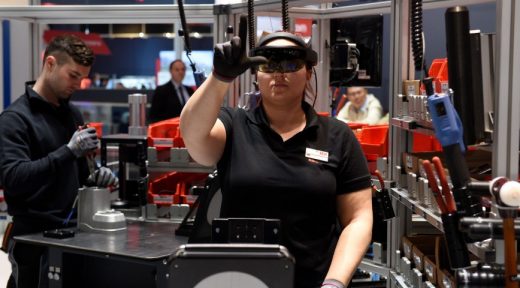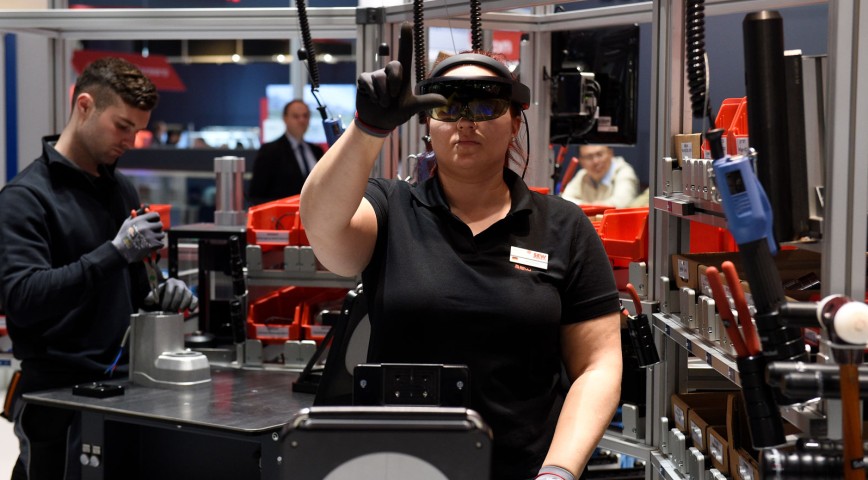Wearable tech hits the factory floor at Hannover Messe
Wearable tech hits the factory floor at Hannover Messe

Germany has always been a place for industrial invention and innovation, reflected by the creation of the concept of “Industrie 4.0” by the German Government.
Last week saw Europe’s leading technologists involved in the digitalization of industry bought together at Hannover Messe to showcase their answers to the key question faced by industrial enterprises everywhere: How can I best get my company into shape for the digital future?
See also: Industrial IoT — think of it as a May-December romance
One of the key innovations showcases was enterprise wearable tech, designed for workplace scenarios. Here are some of the more interesting products (and some of the software behind them) that were on display.

Fraunhofer’s wearables for order picking
Fraunhofer IIS utilizes magnetic field localization to support order picking. This is done by placing a coil around a shelf. The system uses a second coil placed in a wearable to help visualize the information for the picker. The system uses a second coil placed in a wearable to identify which compartment the employee is reaching into.

Daqri’s smart helmet
The DAQRI smart helmet is the first augmented reality helmet form-factor purpose built for use in industrial IoT environments that require hard-hats. It combines advanced processing power, cameras, and sensors to enable unsurpassed computer vision and AR experiences. And it is designed to satisfy personal protection equipment requirements. It incorporates an Intel core M7
It incorporates an Intel core M7 processor and the latest Intel camera technology. It is also equipped with a thermal camera which is supplemented by Thermographer, a new 3-D thermal mapping service for DAQRI Smart Helmet.

Noone’s Chairless Chair
Possibly one of the strangest looking wearables of late, the Chairless Chair, is particularly suitable for production employees on the factory floor. This Swiss innovation weighs less than four kilograms and enables its wearer to sit anywhere without a seat.
The solution is both simple and ingenious. It can be worn while walking and moved into the desired seating position at the touch of a button. It is user-friendly and can be switched quickly between standing, sitting and walking at any time. It can also be adjusted hydraulically to suit the wearer’s build and desired seating position. It promotes good posture and thus the well-being of its wearer, which can ultimately also help boost productivity.
Its creator, Noonee, was a finalist in the MESSE International Technology Prize at the show. Similar technology has been utilized to created wearable chairs for surgeons undertaking long operations in Japan.

Brochesia’s warehouse management
Companies are increasingly incorporating platforming technology into wearables such as smart glasses, to enable hands-free activity for workers who exist in a deskless environment. The Italian company, Brochesia, is one company that creates smart glass applications for warehouse management.
Its platform, B Take, provides support during logistics activities, enabling hands-free goods management during the receipt handling and collection of goods, allowing to a faster, optimized process, intent on reducing human errors, thanks to code reading and gesture commands
Kinemic’s gesture control
German startup Kinemic has created software that allows users to control devices using gestures and input words and numbers simply by writing in the air. Completely hands-free operation of different devices is thus made possible. A sensor wristband or smartwatch records hand and arm movements which are then translated into gestures or text.

Motion Miners’ beacon tech
Motion Miners have created beacon technology that can be implemented in manual processing. Real-time gesture recognition is enabled between humans and machines and automated guided vehicles or pick-by-light systems can be operated and controlled with gestures.
Motion Mining also helps analyze and quantify manual processes automatically. For example, the process can be decomposed into walking, picking, base or dead time. This allows for the identification of weak points, the improvement of manual processes and ultimately saving money.Work safety and ergonomic also play an important role within manual processes as poor ergonomics and workplace safety can be monitored with real-time feedback delivered to employees. In the case of drops and collisions, alarms are sent to the control room.
See also: World Economic Forum opens Industry 4.0 center in San Francisco
Work safety and ergonomic also play an important role within manual processes as poor ergonomics and workplace safety can be monitored with real-time feedback delivered to employees. In the case of drops and collisions, alarms are sent to the control room.
While the demand for consumer wearable tech tends to oscillate throughout different times of the year, workplace wearables are holding steadfast and provide a means to increase automation, reduce manual processing and increase worker health and wellbeing. There is substantial applicability across a range of industries from manufacturing to mining and medical, and it’s foreseeable that use cases will continue to develop as wearables become a key component of a worker’s toolkit.
The post Wearable tech hits the factory floor at Hannover Messe appeared first on ReadWrite.
(31)



